河北科技大学:《发酵工艺原理》课程教学资源(PPT课件)微生物培养基 Cultural media
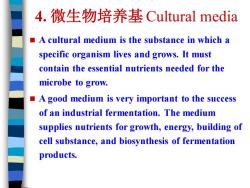
4. 微生物培养基 Cultural media ◼ A cultural medium is the substance in which a specific organism lives and grows. It must contain the essential nutrients needed for the microbe to grow. ◼ A good medium is very important to the success of an industrial fermentation. The medium supplies nutrients for growth, energy, building of cell substance, and biosynthesis of fermentation products
4. 微生物培养基 Cultural media ◼ A cultural medium is the substance in which a specific organism lives and grows. It must contain the essential nutrients needed for the microbe to grow. ◼ A good medium is very important to the success of an industrial fermentation. The medium supplies nutrients for growth, energy, building of cell substance, and biosynthesis of fermentation products

4.1 培养基的类型及功能 Classifications of media and their functions ◼ 按纯度分类: -合成培养基 chemically defined media: compound identity and concentration of all components are known. Synthetic media -天然培养基 chemically undefined media: ingredients include one or more chemically complex substances such as protein hydrolysates and extracts. Crude media
4.1 培养基的类型及功能 Classifications of media and their functions ◼ 按纯度分类: -合成培养基 chemically defined media: compound identity and concentration of all components are known. Synthetic media -天然培养基 chemically undefined media: ingredients include one or more chemically complex substances such as protein hydrolysates and extracts. Crude media

◼ The choice of defined or undefined medium is dependent upon its application. -Chemically defined media are useful in biochemical or metabolic studies of organisms. -General laboratory growth media and industrial media are often chemically complex. Such as 花 生饼、蛋白胨等。一般不需外加微量元素 (trace elements)、维生素等
◼ The choice of defined or undefined medium is dependent upon its application. -Chemically defined media are useful in biochemical or metabolic studies of organisms. -General laboratory growth media and industrial media are often chemically complex. Such as 花 生饼、蛋白胨等。一般不需外加微量元素 (trace elements)、维生素等
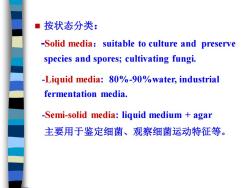
◼ 按状态分类: -Solid media:suitable to culture and preserve species and spores; cultivating fungi. -Liquid media: 80%-90%water, industrial fermentation media. -Semi-solid media: liquid medium + agar 主要用于鉴定细菌、观察细菌运动特征等
◼ 按状态分类: -Solid media:suitable to culture and preserve species and spores; cultivating fungi. -Liquid media: 80%-90%water, industrial fermentation media. -Semi-solid media: liquid medium + agar 主要用于鉴定细菌、观察细菌运动特征等
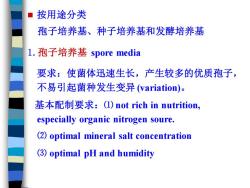
◼ 按用途分类 孢子培养基、种子培养基和发酵培养基 1.孢子培养基 spore media 要求:使菌体迅速生长,产生较多的优质孢子, 不易引起菌种发生变异 (variation)。 基本配制要求:⑴ not rich in nutrition, especially organic nitrogen soure. ⑵ optimal mineral salt concentration ⑶ optimal pH and humidity
◼ 按用途分类 孢子培养基、种子培养基和发酵培养基 1.孢子培养基 spore media 要求:使菌体迅速生长,产生较多的优质孢子, 不易引起菌种发生变异 (variation)。 基本配制要求:⑴ not rich in nutrition, especially organic nitrogen soure. ⑵ optimal mineral salt concentration ⑶ optimal pH and humidity
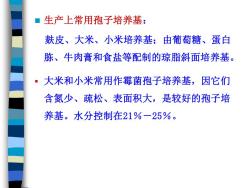
◼ 生产上常用孢子培养基: 麸皮、大米、小米培养基;由葡萄糖、蛋白 胨、牛肉膏和食盐等配制的琼脂斜面培养基。 ▪ 大米和小米常用作霉菌孢子培养基,因它们 含氮少、疏松、表面积大,是较好的孢子培 养基。水分控制在21%-25%
◼ 生产上常用孢子培养基: 麸皮、大米、小米培养基;由葡萄糖、蛋白 胨、牛肉膏和食盐等配制的琼脂斜面培养基。 ▪ 大米和小米常用作霉菌孢子培养基,因它们 含氮少、疏松、表面积大,是较好的孢子培 养基。水分控制在21%-25%
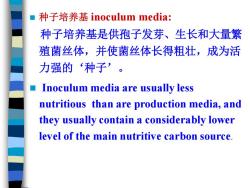
◼ 种子培养基 inoculum media: 种子培养基是供孢子发芽、生长和大量繁 殖菌丝体,并使菌丝体长得粗壮,成为活 力强的‘种子’ 。 ◼ Inoculum media are usually less nutritious than are production media, and they usually contain a considerably lower level of the main nutritive carbon source
◼ 种子培养基 inoculum media: 种子培养基是供孢子发芽、生长和大量繁 殖菌丝体,并使菌丝体长得粗壮,成为活 力强的‘种子’ 。 ◼ Inoculum media are usually less nutritious than are production media, and they usually contain a considerably lower level of the main nutritive carbon source
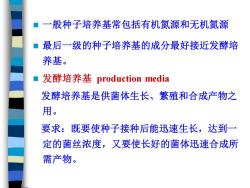
◼ 一般种子培养基常包括有机氮源和无机氮源 ◼ 最后一级的种子培养基的成分最好接近发酵培 养基。 ◼ 发酵培养基 production media 发酵培养基是供菌体生长、繁殖和合成产物之 用。 要求:既要使种子接种后能迅速生长,达到一 定的菌丝浓度,又要使长好的菌体迅速合成所 需产物
◼ 一般种子培养基常包括有机氮源和无机氮源 ◼ 最后一级的种子培养基的成分最好接近发酵培 养基。 ◼ 发酵培养基 production media 发酵培养基是供菌体生长、繁殖和合成产物之 用。 要求:既要使种子接种后能迅速生长,达到一 定的菌丝浓度,又要使长好的菌体迅速合成所 需产物

◼ 配制要求:其组成除有菌体生长所必需 的元素和化合物外,还需有合成产物所 需的特定元素、前体和促进剂等。 ◼ In addition to the carbon and nitrogen compounds, a medium contains inorganic salts, vitamins, growth factors, precursors of fermentation products
◼ 配制要求:其组成除有菌体生长所必需 的元素和化合物外,还需有合成产物所 需的特定元素、前体和促进剂等。 ◼ In addition to the carbon and nitrogen compounds, a medium contains inorganic salts, vitamins, growth factors, precursors of fermentation products
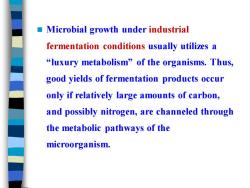
◼ Microbial growth under industrial fermentation conditions usually utilizes a “luxury metabolism” of the organisms. Thus, good yields of fermentation products occur only if relatively large amounts of carbon, and possibly nitrogen, are channeled through the metabolic pathways of the microorganism
◼ Microbial growth under industrial fermentation conditions usually utilizes a “luxury metabolism” of the organisms. Thus, good yields of fermentation products occur only if relatively large amounts of carbon, and possibly nitrogen, are channeled through the metabolic pathways of the microorganism
按次数下载不扣除下载券;
注册用户24小时内重复下载只扣除一次;
顺序:VIP每日次数-->可用次数-->下载券;
- 河北科技大学:《发酵工艺原理》课程教学资源(PPT课件)第二章 菌种的来源.ppt
- 河北科技大学:《发酵工艺原理》课程教学资源(PPT课件)第一章 绪论(授课人:冯惠勇).ppt
- 江南大学:《食品安全学》课程教学课件(PPT讲稿)第五章 食品敏感性、过敏性反应和食品不耐性.ppt
- 江南大学:《食品安全学》课程教学课件(PPT讲稿)第四章 风险分析框架.ppt
- 江南大学:《食品安全学》课程教学课件(PPT讲稿)第三章 转基因食品与安全性.ppt
- 江南大学:《食品安全学》课程教学课件(PPT讲稿)第二章 保证食品安全的加工方式.ppt
- 江南大学:《食品安全学》课程教学课件(PPT讲稿)第一章 前言 Food Safety.ppt
- 浙江工商大学:《食品感官科学》课程教学课件(讲稿)第七讲 食品感官品质物质基础.pdf
- 浙江工商大学:《食品感官科学》课程教学课件(讲稿)第六讲 食品感官嗜好.pdf
- 浙江工商大学:《食品感官科学》课程教学课件(讲稿)第五讲 感官科学实验室.pdf
- 浙江工商大学:《食品感官科学》课程教学课件(讲稿)第四讲 感官分析方法学.pdf
- 浙江工商大学:《食品感官科学》课程教学课件(讲稿)第三讲 感官分析实验心理学模型.pdf
- 浙江工商大学:《食品感官科学》课程教学课件(讲稿)第二讲 人类的感官与感觉(下).pdf
- 浙江工商大学:《食品感官科学》课程教学课件(讲稿)第二讲 人类的感官与感觉(上).pdf
- 浙江工商大学:《食品感官科学》课程教学课件(讲稿)第一讲 食品感官科学引论(下).pdf
- 浙江工商大学:《食品感官科学》课程教学课件(讲稿)第一讲 食品感官科学引论(上).pdf
- 浙江工商大学:《食品感官科学》课程教学课件(讲稿)第九讲 智能感官仿生学(下).pdf
- 浙江工商大学:《食品感官科学》课程教学课件(讲稿)第九讲 智能感官仿生学(上).pdf
- 浙江工商大学:《食品感官科学》课程教学课件(讲稿)第八讲 食物质构与口感(下).pdf
- 浙江工商大学:《食品感官科学》课程教学课件(讲稿)第八讲 食物质构与口感(中).pdf
- 河北科技大学:《发酵工艺原理》课程教学资源(PPT课件)第三章 灭菌.ppt
- 河北科技大学:《发酵工艺原理》课程教学资源(PPT课件)第四章 种子制备与菌种保藏.ppt
- 河北科技大学:《发酵工艺原理》课程教学资源(PPT课件)第五章 发酵过程动力学的基本概念.ppt
- 河北科技大学:《发酵工艺原理》课程教学资源(PPT课件)第七章 发酵工艺控制.ppt
- 河北科技大学:《发酵工艺原理》课程教学资源(PPT课件)第八章染菌的防治.ppt
- 中国农业大学:《食品工艺学》课程教学资源(PPT课件)绪论(主讲教师:李博).ppt
- 中国农业大学:《食品工艺学》课程教学资源(PPT课件)第一篇 肉制品加工技术.ppt
- 中国农业大学:《食品工艺学》课程教学资源(PPT课件)第二篇 乳与乳制品加工技术 第一章 乳的基本知识 2.1.1 第一节 绪论.ppt
- 中国农业大学:《食品工艺学》课程教学资源(PPT课件)第二篇 乳与乳制品加工技术 第一章 乳的基本知识 2.1.2 第二节 乳的概念.ppt
- 中国农业大学:《食品工艺学》课程教学资源(PPT课件)第二篇 乳与乳制品加工技术 第一章 乳的基本知识 2.1.3 第三节 牛乳的组成.ppt
- 中国农业大学:《食品工艺学》课程教学资源(PPT课件)第二篇 乳与乳制品加工技术 第一章 乳的基本知识 2.1.4 第四节 牛乳成分的化学性质.ppt
- 中国农业大学:《食品工艺学》课程教学资源(PPT课件)第二篇 乳与乳制品加工技术 第一章 乳的基本知识 2.1.5 第五节 乳的物理性质.ppt
- 中国农业大学:《食品工艺学》课程教学资源(PPT课件)第二篇 乳与乳制品加工技术 第二章 饮用乳的生产 2.2.1 第一节 消毒鲜乳的概念.ppt
- 中国农业大学:《食品工艺学》课程教学资源(PPT课件)第二篇 乳与乳制品加工技术 第二章 饮用乳的生产 2.2.2 第二节 原料乳验收与预处理.ppt
- 中国农业大学:《食品工艺学》课程教学资源(PPT课件)第二篇 乳与乳制品加工技术 第二章 饮用乳的生产 2.2.3 第三节 全脂消毒牛乳的生产.ppt
- 中国农业大学:《食品工艺学》课程教学资源(PPT课件)第二篇 乳与乳制品加工技术 2.3 第三章 冰淇淋的生产.ppt
- 中国农业大学:《食品工艺学》课程教学资源(PPT课件)第二篇 乳与乳制品加工技术 第四章 乳粉生产工艺 2.4.1 第一节 概述.ppt
- 中国农业大学:《食品工艺学》课程教学资源(PPT课件)第二篇 乳与乳制品加工技术 第四章 乳粉生产工艺 2.4.2 第二节 全脂加糖乳粉的生产工艺.ppt
- 中国农业大学:《食品工艺学》课程教学资源(PPT课件)第二篇 乳与乳制品加工技术 第四章 乳粉生产工艺 2.4.3 第三节 全脂速溶乳粉.ppt
- 中国农业大学:《食品工艺学》课程教学资源(PPT课件)第二篇 乳与乳制品加工技术 第五章 酸乳制品及乳酸菌制剂 2.5.1 第一节 概述.ppt
